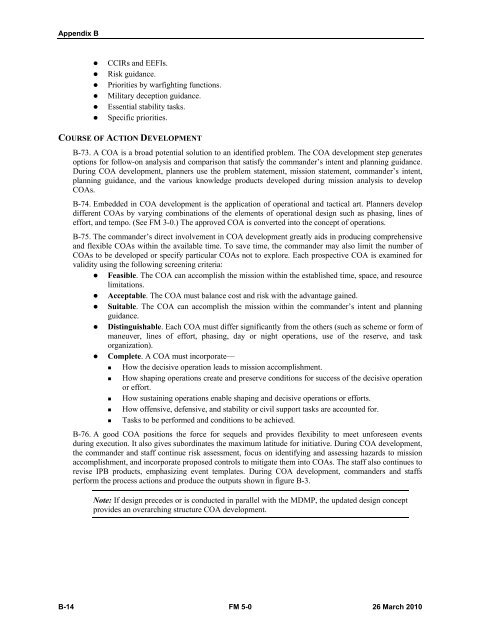FM 5-0, The Operations Process - Federation of American Scientists
FM 5-0, The Operations Process - Federation of American Scientists
FM 5-0, The Operations Process - Federation of American Scientists
Create successful ePaper yourself
Turn your PDF publications into a flip-book with our unique Google optimized e-Paper software.
Appendix B<br />
• CCIRs and EEFIs.<br />
• Risk guidance.<br />
• Priorities by warfighting functions.<br />
• Military deception guidance.<br />
• Essential stability tasks.<br />
• Specific priorities.<br />
COURSE OF ACTION DEVELOPMENT<br />
B-73. A COA is a broad potential solution to an identified problem. <strong>The</strong> COA development step generates<br />
options for follow-on analysis and comparison that satisfy the commander’s intent and planning guidance.<br />
During COA development, planners use the problem statement, mission statement, commander’s intent,<br />
planning guidance, and the various knowledge products developed during mission analysis to develop<br />
COAs.<br />
B-74. Embedded in COA development is the application <strong>of</strong> operational and tactical art. Planners develop<br />
different COAs by varying combinations <strong>of</strong> the elements <strong>of</strong> operational design such as phasing, lines <strong>of</strong><br />
effort, and tempo. (See <strong>FM</strong> 3-0.) <strong>The</strong> approved COA is converted into the concept <strong>of</strong> operations.<br />
B-75. <strong>The</strong> commander’s direct involvement in COA development greatly aids in producing comprehensive<br />
and flexible COAs within the available time. To save time, the commander may also limit the number <strong>of</strong><br />
COAs to be developed or specify particular COAs not to explore. Each prospective COA is examined for<br />
validity using the following screening criteria:<br />
• Feasible. <strong>The</strong> COA can accomplish the mission within the established time, space, and resource<br />
limitations.<br />
• Acceptable. <strong>The</strong> COA must balance cost and risk with the advantage gained.<br />
• Suitable. <strong>The</strong> COA can accomplish the mission within the commander’s intent and planning<br />
guidance.<br />
• Distinguishable. Each COA must differ significantly from the others (such as scheme or form <strong>of</strong><br />
maneuver, lines <strong>of</strong> effort, phasing, day or night operations, use <strong>of</strong> the reserve, and task<br />
organization).<br />
• Complete. A COA must incorporate—<br />
• How the decisive operation leads to mission accomplishment.<br />
• How shaping operations create and preserve conditions for success <strong>of</strong> the decisive operation<br />
or effort.<br />
• How sustaining operations enable shaping and decisive operations or efforts.<br />
• How <strong>of</strong>fensive, defensive, and stability or civil support tasks are accounted for.<br />
• Tasks to be performed and conditions to be achieved.<br />
B-76. A good COA positions the force for sequels and provides flexibility to meet unforeseen events<br />
during execution. It also gives subordinates the maximum latitude for initiative. During COA development,<br />
the commander and staff continue risk assessment, focus on identifying and assessing hazards to mission<br />
accomplishment, and incorporate proposed controls to mitigate them into COAs. <strong>The</strong> staff also continues to<br />
revise IPB products, emphasizing event templates. During COA development, commanders and staffs<br />
perform the process actions and produce the outputs shown in figure B-3.<br />
Note: If design precedes or is conducted in parallel with the MDMP, the updated design concept<br />
provides an overarching structure COA development.<br />
B-14 <strong>FM</strong> 5-0 26 March 2010















